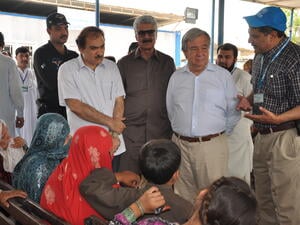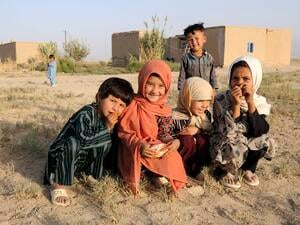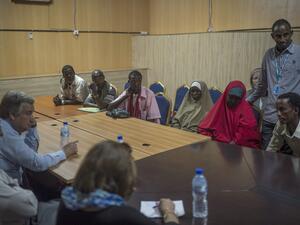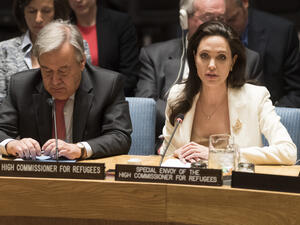Migration, Displacement and Planned Relocation
Migration, Displacement and Planned Relocation
This article originally appeared in Spanish in Migración Humana y Cambio Climático, published by Fundación BBVA Bancomer, Mexico, 2012.
Migration, Displacement and Planned Relocation
António Guterres, United Nations High Commissioner for Refugees[1]
Climate change, global warming and the resulting environmental pressures are the defining challenges of our times. There is also evidence that natural disasters are growing in frequency and intensity in the context of climate change.[2]
The climate change phenomenon cannot be viewed or addressed in isolation from the other global mega-trends that are conditioning the future of our planet and its people: population growth, urbanization, water scarcity, food and energy insecurity, and volatile commodity prices; all against the backdrop of the global economic crisis. Looking to the future, it seems certain that these trends will increasingly interact with each other, creating the potential for fierce competition over scarce natural resources, as well as violent conflict.
In this context, the world is likely to see growing numbers of people becoming displaced within their countries or across national borders. Some externally displaced persons may qualify for refugee status under the terms of the 1951 Convention relating to the Status of Refugees, though this is unlikely to be the case for the majority.
This contribution describes how the effects of climate change will lead to increased human mobility in the form of migration, displacement and planned relocation of communities as areas gradually become less hospitable or uninhabitable or experience sudden disasters. [3] It aims to spur further reflection on how to address the challenges that are likely to result.
Climate change will have a multiplier effect on other trends
Many of the reports published on climate change, migration and displacement speculate or make projections about the scale of such population movements and their potential security and other consequences.[4] There is no consensus on the numbers nor can there be. Climate change is not an independent factor or phenomenon that can be examined in isolation. It is not a direct, exclusive driver of population movements, but rather a 'multiplier' of other factors.
As noted in the recent UK Government Office for Science 'Foresight' report, "(T)he range and complexity of the interactions between these drivers means that it will rarely be possible to distinguish individuals for whom environmental factors are the sole drivers." [5] As such, it is inherently risky to speak of 'climate change' as the 'cause' of human movement, even though its impacts are certain to exacerbate existing socio-economic or environmental vulnerabilities which could drive people to move.
Migration and displacement will increase
Migration in response to environmental changes has been a constant throughout human history and is a rational adaptation strategy. Over the past two decades, a consensus has emerged that one of the major effects of climate change will be on human mobility.[6] Yet the international community has been slow to think through and act upon some of the implications. [7] New challenges today include the speed with which climate change is occurring; the large number of people susceptible to the effects of those changes[8]; and the rapid pace at which people's traditional coping strategies are likely to be overwhelmed. As the IPCC has observed, '[w]hile physical exposure can significantly influence vulnerability for both human populations and natural systems, a lack of adaptive capacity is often the most important factor that creates a hotspot of human vulnerability'. [9]
The continued inability of the international community to strike a deal to curb greenhouse gas emissions and set in place effective cooperation to mitigate and adapt to climate change means that the planet is already facing the worst-case scenarios predicted to occur, with average global temperature increases of 2°C and above.
In recent years, UNHCR and a number of humanitarian agencies have been active in numerous international initiatives, backed by academic and policy research, to promote greater awareness about the humanitarian consequences of climate change, including in terms of displacement. [10]
It was a welcome development when the Conference of Parties to the United Nations Framework Convention on Climate Change (UNFCCC), meeting in Cancun (COP 16) in December 2010, recognized the potential impact of climate change on the movement of people and invited all parties to the Convention:
"to enhance action on adaptation under the Cancun Adaptation Framework … by undertaking inter alia, the following: …(f) Measures to enhance understanding, coordination and cooperation with regard to climate change induced displacement, migration and planned relocation, where appropriate, at national, regional and international levels."[11]
This paragraph is important for several reasons. It marks the first occasion that the COP recognized human mobility as an adaptation strategy. Not only does the language identify three types of mobility (climate change-induced displacement, migration and planned relocation), it also calls for three types of action (enhancing understanding, coordination and cooperation) to be carried out on three levels (national, regional and international). It thus encourages more research and conceptual thinking on the various forms of mobility, while emphasizing the need for a range of actors, working on different levels, to cooperate in these efforts and to coordinate them.[12]
Since mobility will be part of the solution for some affected populations, people must be allowed to exercise choice regarding their future.
Points for further reflection and action
The following points are intended to inspire further thinking on some of the key issues that the international community will have to address.
Movements within national borders
There is broad consensus that much of the movement prompted by climate change will take place within national borders. The 'Foresight' report [13] brings fresh insights by positing that people may be forced to migrate in ways that increase their vulnerability, for example by migrating to areas of high environmental risk, such as low-lying urban areas in mega-deltas or slums in water-insecure and expanding cities.
Primary responsibility for the protection and well being of affected populations rests with the States concerned. At national level, States will need to reinforce the resilience and coping mechanisms of their citizens and communities, while also anticipating and making provision for internal migration as a form of adaptation. In some cases, movements will take the form of 'forced internal displacement'. The Guiding Principles on Internal Displacement are an important guide in this regard.[14] The African Union is to be commended for going a step further and formulating a binding treaty for the protection of internally displaced people. Under the AU Convention for the Protection and Assistance of Internally Displaced Persons in Africa - known as the Kampala IDP Convention - States Parties commit to "take measures to protect and assist persons who have been internally displaced due to natural or human made disasters, including climate change." [15]
To protect the rights and meet the needs of the displaced, governments in the developing world will need strong support from the world's industrialized and industrializing States which bear primary responsibility for the process of climate change. It will also be important for regional frameworks and international cooperation to buttress action at national level and contribute to building national capacity. However, the nature of international support must change.
Traditionally, the international community has responded to disasters and displacement in emergency mode, establishing camps, distributing food and water, building schools and clinics. This approach must be reconsidered. The billions of dollars spent on relief in recent decades have evidently not led to the sustainable strengthening of national and local capacities. National adaptation plans will need to take full account of the linkage between the effects of climate change and human mobility. This includes making provision for the growing proportion of people who are forced to leave their land and move to urban areas, where it makes no sense to accommodate them in camps or to establish separate services for their benefit. A development-oriented and area-wide approach is thus required, ensuring that the most vulnerable and marginalized members of society are able to enjoy the human security and human rights to which they are entitled.
It is equally imperative for the international community to make good on promises to set in place a massive programme of support for adaptation in developing countries where this is needed. Such action should take full account of the fact that women - especially poor women - are often amongst the seriously affected by climate change and natural disasters.
Cross-border movements
A quick analysis of existing national legislation indicates that a number of countries have included provisions whereby persons affected by natural disasters would not be returned to their countries of origin and would enjoy a form of temporary protection. [16] However, the vast majority of States make no provision in their legal frameworks for the legal immigration and sojourn, even if temporary, of residents of islands subjected to sea level rise or others exposed to the impacts of climate change.
At the global level, the Bellagio Expert Roundtable on Climate Change and Displacement[17] recognized that a range of international and regional instruments may provide responses to various forms of external displacement related to climate change. However, these instruments only cover a limited group of displaced persons. They generally have not been applied to persons who are forced or compelled to cross an international border due to natural disasters, or who cannot return as a result of such events, either temporarily or permanently. Nor do they apply to people who cannot return because their land has become uninhabitable as a result of the long-term effects of climate change. [18]
At the same time, it is clear that the 1951 Convention may apply in specific situations, for instance, where "victims of natural disasters flee because their government has consciously withheld or obstructed assistance in order to punish or marginalize them on one of the five [Convention] grounds." [19] These actions may take place in situations of armed conflict, generalized violence, public disorder or political instability, or even in peacetime.
The idea of 'ecological refugee' was first mentioned in 1948,[20] but it was not until 1985 that the term 'environmental refugee' was coined to highlight the potentially devastating need for humans to escape from the impacts of unchecked development and pollution.[21] Then and now, however, the term 'refugee' is legally incorrect in this context. [22] Adopting the terminology of "climate refugees" or "environmental refugees" would only complicate and confuse UNHCR's efforts to protect the victims of persecution and armed conflict.
Even if they are not refugees, however, such people are entitled to be supported and to have their voices heard and taken into account. But what form should that support take?
UNHCR explored this question during expert discussions organized as part of commemorations of the 60th anniversary of the Refugee Convention and the 50th anniversary of the Convention on the Reduction of Statelessness in 2011. The Bellagio Expert Roundtable examined protection gaps and potential responses linked to climate-related external displacement, and reached a number of broad understandings. [23] The Norwegian Government's Nansen Conference on Climate Change and Displacement (June 2011) developed 10 Nansen Principles, which include recognition that, "A more coherent and consistent approach at the international level is needed to meet the protection needs of people displaced externally owing to sudden-onset disasters. States, working in conjunction with UNHCR and other relevant stakeholders, could develop a guiding framework or instrument in this regard." [24]
During an intergovernmental event at ministerial level organized by UNHCR in December 2011, UN Member States adopted a Ministerial Communiqué which states that, "We will reinforce cooperation with each other and work with UNHCR and other relevant stakeholders, as appropriate, to deepen our understanding of evolving patterns of displacement and to agree upon ways to respond to the challenges we face in a changing global context." [25]
Pursuant to pledges made by a group of States during this intergovernmental event, UNHCR will work together with them in the development of a framework on external displacement related to climate change, which could take the form of temporary or interim protection arrangements. Consultations with interested States could assist in identifying scenarios in which such arrangements would be activated, and could help to develop procedures and standards of treatment for affected populations.
Regional and sub-regional treaties, such as the free movement protocols of the Economic Community of West African States, could also be invoked in this respect. While those protocols were developed primarily to strengthen economic integration, rather than to serve as refugee or human rights instruments, they may have a new relevance in relation to the plight of people who move from one country to another due to the consequences of climate change and natural disasters.
Planned relocation
In addition to expected increases in migration and displacement, planned relocation is likely to be another policy response to environmental pressures. Governments may legitimately wish to move communities out of harm's way or from areas that are no longer inhabitable. This is a policy option that has received relatively little attention.
States have a lot of experience with development-forced displacement and resettlement (DFDR), the term now used more commonly than development-induced displacement. This refers to the involuntary displacement of people and communities due to large-scale infrastructure projects. [26] In this context, resettlement refers to a process of relocation to assist displaced persons to replace their housing, assets, livelihoods and land and to ensure their access to resources and services.
Despite guidelines from the World Bank and multilateral banks intended to ensure that resettled populations are at least as well off as they were before resettlement, the record of DFDR is not a positive one.[27] There seems to be a sense within the DFDR community that successful cases are the exception and that in the vast majority of cases, the resettled population is left much worse off than before.[28]
If planned relocation becomes a component of State policies on adaptation to climate change, more research will be needed to identify good practice examples and what made them successful, while also developing additional guidance on protecting the human rights of those who will be affected.
Small island nations
Steps must also be taken to address the plight of people living on small and low-lying islands whose lives, livelihoods, culture and identity are threatened by rising sea levels. Some creative adaptation efforts are underway, but in-country relocation or migration abroad is also already occurring. While most inhabitants will wish to remain, posing very specific adaptation challenges, some will wish to migrate abroad. Where will these islanders go as conditions become more and more untenable over time?
Like climate change processes themselves, movement away from small island and/or low-lying coastal states is likely to be slow and gradual, although some events such as cyclones or king tides may, in the interim period, trigger more sudden but probably temporary (and internal) movements.
It has been suggested that some small island and/or low-lying coastal States may cease to exist owing to sea-level rise and its impacts on the State and its people. There is a general presumption of continuity of statehood and international legal personality under international law, so statehood will not be lost automatically with the loss of habitable territory, nor is it necessarily affected by population movements. The language of "disappearing" or "sinking" islands ought, therefore, to be avoided.
Nonetheless, there are profound humanitarian and protection issues that remain to be addressed, and the international community is encouraged to examine policy, legal, operational, humanitarian and resource responses. This is a particularly complex area, which is likely to require various strategies and responses. These may include adaptation measures, such as relocation and/or migration. Any measures put forward to affected communities should respect their right to self-determination.[29]
Conclusion
The issue of human mobility in the context of climate change is complex, raising a number of questions and requiring urgent responses. The international community needs to marshal the political will and cooperative spirit required to reduce the pace of climate change. Immediate steps are necessary to mitigate this process, introduce appropriate adaptation strategies and limit the extent to which climate change exacerbates forced displacement. If climate change continues at its current pace, and if we fail to find sustainable solutions for displaced populations, we will leave a poisoned legacy to future generations and increasing threats to peace and security all over the world.
[1] UNHCR is the UN Refugee Agency and a founding member of the Global Migration Group, an inter-agency group bringing together heads of agencies to promote the wider application of all relevant international and regional instruments and norms relating to migration, and to encourage the adoption of more coherent, comprehensive and better coordinated approaches to the issue of international migration.
[2] IDMC and NRC, 'Displacement due to natural hazard-induced disasters: Global estimates for 2009 and 2010', June 2011.
[3] The most commonly accepted climate change scenarios are:
• hydro-meteorological disasters (flooding, hurricanes/typhoons/cyclones, mudslides, etc.);
• displacement from zones designated by Governments as being too high-risk and dangerous for human habitation;
• environmental degradation and slow onset disaster (e.g. reduction of water availability, desertification, recurrent flooding, salinization of coastal zones, etc.);
•the case of small island developing states affected by the rise of sea levels; and,
•violent conflict triggered by a decrease in essential resources (e.g. water, land,
food) owing to climate change.
[4] See especially Stern Review on the Economics of Climate Change, 30 October 2006 http://webarchive.nationalarchives.gov.uk/+/http:/www.hm-treasury.gov.u…
[5] Foresight, Migration and Global Environmental Change (2011), Final Project Report, The Government Office for Science, London, page 9
[6] See e.g. M. Leighton, X. Shen, and K. Warner, "Climate Change and Migration: Rethinking Policies for Adaptation and Disaster Risk Reduction", United Nations University Series, No. 15/2011
[7] António Guterres, "Millions Uprooted: Saving Refugees and the Displaced", Foreign Affairs, September/October 2008, available at http://www.foreignaffairs.org/20080901 faessay87506/antonio-guterres/millions-uprooted.htmls
[8] Projections vary from 50 million to 250 million by 2050 Oli Brown, "The Numbers Game" (2008) 31 Forced Migration Review 8.
[9] IPCC, Climate Change 2007: Impacts, Adaptation and Vulnerability: Contribution of Working Group II to the Fourth Assessment Report of the Intergovernmental Panel on Climate Change (Cambridge: CUP, 2007) 317.
[10] See IASC Informal Group on Migration/Displacement and Climate Change, "Climate Change, Migration and Displacement: Who will be affected?", 31 October 2008; Submission by the International Organization for Migration (IOM), the United Nations High Commissioner for Refugees (UNHCR) and the United Nations University (UNU) in cooperation with the Norwegian Refugee Council (NRC) and the Representative of the Secretary-General on the Human Rights of Internally Displaced Persons (RSG on the HR of IDPs), "Climate change, migration and displacement: impacts, vulnerability, and adaptation options", 6 February 2009, 5th session of the Ad Hoc Working Group on Long-Term Cooperative Action under the Convention (AWG-LCA 5), Bonn, March 29 - April 8, 2009; UNHCR, supported by IOM and NRC, "Submission, Climate Change and Statelessness: An Overview to the 6th session of the Ad Hoc Working Group on Long-Term Cooperative Action (AWG-LCA 6) under the UN Framework Convention on Climate Change (UNFCCC) 1 to 12 June 2009, Bonn, Germany, 15 May 2009; Submission by UNHCR, in cooperation with the Norwegian Refugee Council, the Representative of the Secretary-General on the Human Rights of Internally Displaced Persons, and the United Nations University to the 6th session of the Ad Hoc Working Group on Long-Term Cooperative Action under the Convention (WAG-LCA 6) from 1 until 12 June in Bonn, 20 May 2009, "Forced Displacement in the Context of Climate Change: Challenges for States under International Law"; UNHCR, IOM, Norwegian Refugee Council, UNU, "Non Paper: Comments and Proposed Revisions to the negotiating text prepared by the Chair of the UNFCCC Ad Hoc Working Group on long-term cooperative action, to the 6th session of the Ad Hoc Working Group on Long-Term Cooperative Action under the Convention (AWG-LCA 6) 1-12 June, Bonn", with the support of the Representative of the Secretary General on the Human Rights of Internally Displaced Persons, 5 June 2009. Report of the Secretary-General, "Climate change and its possible security implications", UN Doc. A/64/350, 11 September 2009 (hereafter Secretary-General Report on Climate Change); Council of Europe Parliamentary Assembly, "Environmentally induced migration and displacement: a 21st century challenge", Doc. 11785, 23 December 2008; F. Laczko and C. Aghazarm (ed.), Migration, Environment and Climate Change: Assessing the Evidence, International Organization for Migration, Geneva, 2009. Also see UNHCR, "Climate change, natural disasters and human displacement: a UNHCR Perspective", 14 August 2009, available at http://www.unhcr.org/4901e81a4.html
[11] UNFCCC, Outcome of the work of the Ad Hoc Working Group on long-term Cooperative Action under the Convention, CP 16, 2010, http://unfccc.int/files/meetings/cop_16/application/pdf/cop16_lca.pdf#p…, para 14(f)
[12] See Ferris, op cit. For a description of the process in which this resolution was adopted, see Koko Warner, Climate Change Induced Displacement: Adaptation Policy in the Context of the UNFCCC Climate Negotiations, May 2011.
[13] Foresight: Migration and Global Environmental Change (2011), Final Report, The Government Office for Science, London, page 13.
[14] http://www.idpguidingprinciples.org/
[15] Article 5, para. 4, http://www.unhcr.org/4ae9bede9.html
[16] See for example the legislation of the United States of America. http://www.uscis.gov/ilink/docView/SLB/HTML/SLB/0-0-0-1/0-0-0-29/0-0-0-…
[17] UNHCR, Summary of Deliberations, Climate Change and Displacement: Identifying Gaps and Responses, Bellagio Expert Meeting on Climate Change and Displacement, April 2011, http://www.unhcr.org/4da2b5e19.html
[18] Op cit. paras. 7 and 8
[19] UNHCR, "Forced Displacement in the Context of Climate Change: Challenges for States under International Law", Submission to the 6th Session of the Ad Hoc Working Group on Long-Term Cooperative Action under the Convention, 20 May 2009, pp. 9-10.
[20] W. Vogt, Road to Survival (New York: William Sloane Associates, 1948) in F. Gemenne, 'Environmental Changes and Migration Flows: Normative Frameworks and Policy Responses' (PhD thesis, Institut d'Etudes Politiques de Paris and University of Liège 2009) 114.
[21] E. El-Hinnawi, Environmental Refugees (United Nations Environment Programme, 1985
[22] International law only recognises as refugees, those who meet the criteria set out in the 1951 Convention Relating to the Status of Refugees. That is, a refugee is a person who "owing to a well-founded fear of being persecuted for reasons of race, religion, nationality, membership of a particular social group or political opinion, is outside the country of his nationality and is unable or, owing to such fear, is unwilling to avail himself of the protection of that country; or who, not having a nationality and being outside the country of his former habitual residence as a result of such events, is unable or, owing to such fear, is unwilling to return to it." As the refugee definition only applies to those who have crossed an international border, the difficulties in characterising climate change as 'persecution', and the indiscriminate nature of its impacts, it does not expressly cover those fleeing a natural disaster or slow-onset degradation in living conditions owing to the environment.
[23] UNHCR, Summary of Deliberations on Climate Change and Displacement, thttp://www.unhcr.org/4da2b5e19.html
[24] http://pnc.iucnp.org/wp/wp-content/uploads/2011/06/Chairpersons-Summary…
[25] http://pnc.iucnp.org/wp/wp-content/uploads/2011/06/Chairpersons-Summary…
[26] Such as capital-intensive, high-technology, large-scale projects which convert farmlands, fishing grounds and forests into dam-created reservoirs, irrigation schemes, mining projects, plantations and the like. See Anthony Oliver-Smith, « Development-Forced Displacement and Resettlement : A Global Human Rights Crisis, in Anthony Oliver-Smith (ed.), Development and Dispossession, The Crisis of Forced Displacement and Resettlement, 2009.
[27] Elizabeth Ferris, Protection and Planned Relocation in the Context of Climate Change, Unpublished study, Legal and Protection Policy Research Series, UNHCR, 2012
[28] Ibid.
[29] See Summary of Deliberations, Bellagio Expert Meeting, op. cit., paras. 31-33







